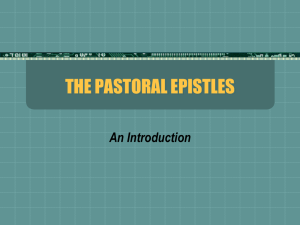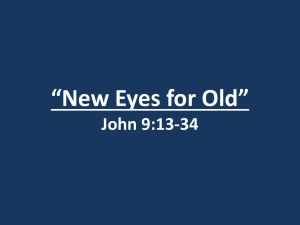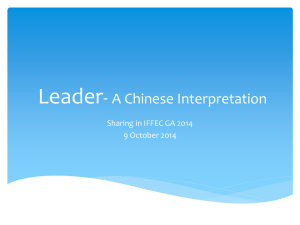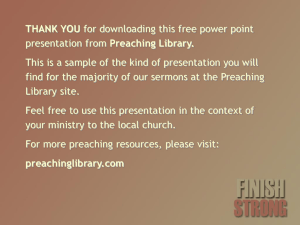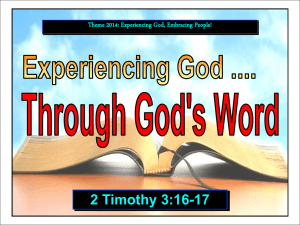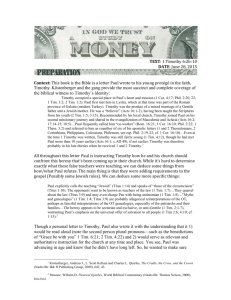BIBH 674 Timothy I
advertisement
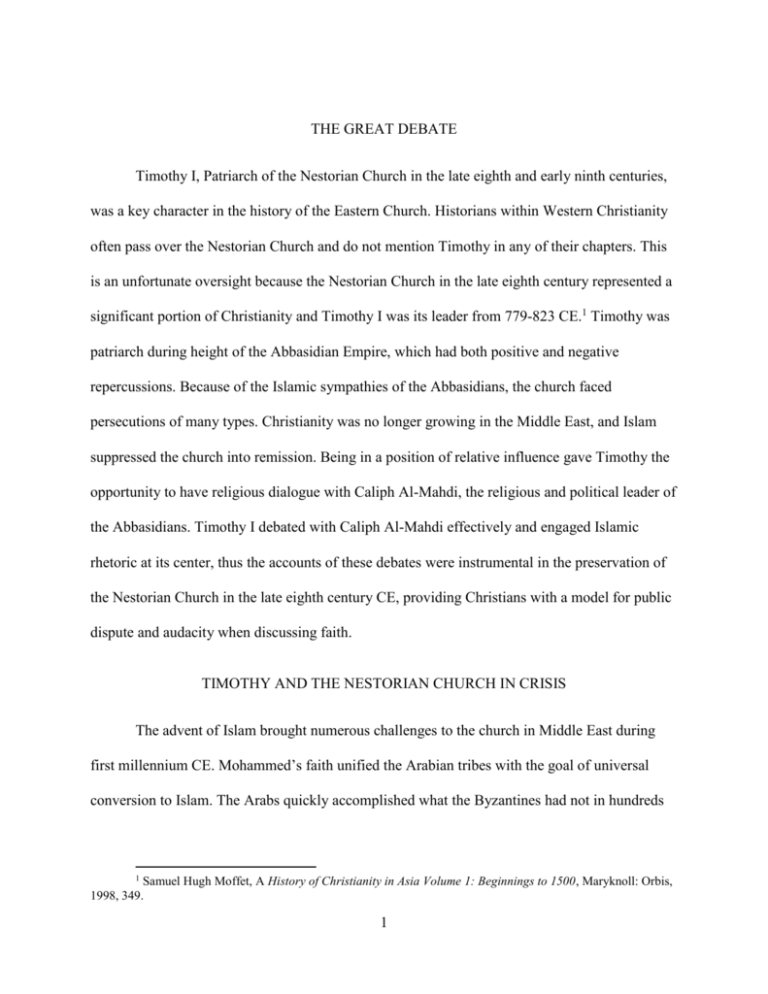
THE GREAT DEBATE Timothy I, Patriarch of the Nestorian Church in the late eighth and early ninth centuries, was a key character in the history of the Eastern Church. Historians within Western Christianity often pass over the Nestorian Church and do not mention Timothy in any of their chapters. This is an unfortunate oversight because the Nestorian Church in the late eighth century represented a significant portion of Christianity and Timothy I was its leader from 779-823 CE.1 Timothy was patriarch during height of the Abbasidian Empire, which had both positive and negative repercussions. Because of the Islamic sympathies of the Abbasidians, the church faced persecutions of many types. Christianity was no longer growing in the Middle East, and Islam suppressed the church into remission. Being in a position of relative influence gave Timothy the opportunity to have religious dialogue with Caliph Al-Mahdi, the religious and political leader of the Abbasidians. Timothy I debated with Caliph Al-Mahdi effectively and engaged Islamic rhetoric at its center, thus the accounts of these debates were instrumental in the preservation of the Nestorian Church in the late eighth century CE, providing Christians with a model for public dispute and audacity when discussing faith. TIMOTHY AND THE NESTORIAN CHURCH IN CRISIS The advent of Islam brought numerous challenges to the church in Middle East during first millennium CE. Mohammed’s faith unified the Arabian tribes with the goal of universal conversion to Islam. The Arabs quickly accomplished what the Byzantines had not in hundreds 1 Samuel Hugh Moffet, A History of Christianity in Asia Volume 1: Beginnings to 1500, Maryknoll: Orbis, 1998, 349. 1 2 of years, which was defeat the Sassanid Empire.2 The Zoroastrian Sassanid lords were far less benevolent to Christianity than the new Islamic Abbasidians, but the lack of religious unity among the Sassanid people curtailed its ability to execute suppressive persecutions. Despite the slaughter of thousands of Christians, Zoroastrianism could not achieve religious dominance in Persian. Islam brought greater religious unity to the Middle East than what the Zoroastrians ever achieved. The new Abbasidian rulers respected Christianity more than the Sassanians and did not violently persecute Christianity to the degree of the Sassanians. However, somewhat inexplicably the new forms of persecution that the Abdisidians brought, which were primarily financial,3 were able to suppress the expansion of Christianity in that region of the world. While Zoroastrians and Christians engaged in intellectual polemics, these arguments were less significant than religious debates would between Islam and Christianity. Islam was a more potent debate partner with Christianity than Zoroastrianism, thus the Nestorian Christians had to create new lines of argument to protect itself from the intellectual pressures that Islam brought.4 Crisis of Faith in the Nestorian Church The Abrahamic faiths have a unique characteristic in common, which the other great eastern religions do not share. Each of the Abrahamic religions is deeply concerned with specific historical events and the progression of history. Judaism is concerned with the Israelite Exodus, Christianity is concerned with the death and resurrection of Jesus, and Islam is concerned with the special revelation of the Quran to Mohammed along with other events. Christianity, being established on the foundation of Judaism, concerns itself with the act of remembering history. In Israelite worship, one remembered the acts of God as a way of ensuring that God was still active 2 Moffet, 335. Moffet, 337. 4 Moffet, 348-57 3 3 in the present history of the people.5 If God were active in the history of a people, then he is likely still involved. The act of remembrance in specifically Christian contexts relates to the giving of the Eucharist. The Eucharist was a way to participate continually in the salvation of Christ until his return. (1 Cor 11:26) Nestorian Christians and Abbasidian Muslims had a high view history and this played a significant role in their dialogue and debates. This special interest in History gave significant advantage to the Muslims over the Christians. Islam had quickly taken over the region with a seemingly unstoppable advance. If one believed that God favored a people group because of its religious convictions, it would be difficult not to see God favoring the Abbasidian Muslims. Many empires across the landscape of human history have claimed divine election, and as long as one empire continued to have sustained military victories, it would be difficult to persuade people that God did not favor that empire. Timothy’s account with Caliph Al-Mahdi does not mention a debate about the Islamic conquest being proof of God’s favor towards Islam. It is possible that Timothy omitted such section from his apology or that Caliph Al-Mahdi did not consider this argument productive for his cause. The problem was not as significant when the Sassanians were in power because despite the more horrendous persecution, Christianity continued to grow. This was not the case after the advent of Islam. This was a clear problem the Nestorian Church. Other Nestorians solved the issue of Muslim lordship similarly to the Hebrew prophets’ resolving the issue of foreign empires conquering Israel.6 Isaiah 10:5 describes Assyria, the conquerors of the Northern Harry Nasuti “Historical Narrative and Identity in the Psalms.” In Horizons of Biblical Theology Vol. 23 (2001), 135. 6 Sidney Griffith “Griffith, Sidney “Disputing With Islam In Syriac: The Case Of The Monk Of Bêt Lê Anda Muslim Emir” Hugoye: Journal of Syriac Studies, Vol. 3 (2000), 34. 5 4 Israelite kingdom, as the rod of God’s wrath. For the Nestorians, casting Islam as the rod of God’s wrath was the easiest way to cope with the problem.7 Christianity as a Matter of Faith For many denominations, Christianity was fundamentally intellectual. One did not need to have high intellectual capacity in order to be a Christian, but the rationale to be a Christian played a large role in the endurance of one’s Christian faith. Christianity did not arise as an indigenous faith that was specific to an ethnic group, but it relied on gaining converts through persuasion. Various Christian groups identified themselves as orthodox, which means correct thinking, highlighting what was important within those groups. One way to bolster the rationale to be a Christian is to make Christianity appear more intellectually viable than the alternative, namely Islam. Writing and disseminating accounts of debates with alternative faiths was one way church leaders sought to accomplish this task. The church leaders needed to provide the church with sound arguments and reasons for their Christian faith. Timothy I, the Patriarch of the Nestorian Christians from 779-823 CE,8 was one of the famous interlocutors of eighth-century Islam, who had the audacity to debate publicly within the burgeoning Abbasidian Empire.9 In his work, The Apology of Timothy I,10 Timothy openly debated Caliph Al-Mahdi about Islam, Christianity and why he refused to acknowledge Mohammed as a prophet from God. Al-Mahdi and many other Islamic polemicists claimed that Mohammed had equal credibility to all the other prophets11 from either the Hebrew Bible or New Testament, thus Griffith, “Disputing with Islam,” 49. Moffet, A History of Christianity in Asia, 349. 9 Timothy was not the first person to debate Islam in the Abbasidian Empire, although he became the most famous. See Griffith “Disputing with Islam in Syriac,” 41. 10 Also known as The Apology of Patriarch Timothy I, Timothy’s Apology, and The Apology of Timothy I before Caliph Al-Mahdi. 11 This group of prophets includes Jesus 7 8 5 Timothy should have acknowledged his authority. Timothy argued vehemently that Christianity was the true religion and the Mohammed was not a true prophet. The positive result of these debates was not the conversion of the Caliph or any Muslim to Christianity, but it was the support of oppressed Christians in their faith. Patriarch Timothy I’s work gave Christians reasons to continue to be Christians in a world that was increasingly hostile towards Christianity. TIMOTHY I AND AL-MAHDI The Nestorian Church remembers Timothy fondly, but the beginning of his patriarchate was clouded with controversy. In order to become patriarch, Timothy implied that some heavy sacks were full of money and that he would give them to the electorate if elected. The electorate voted for Timothy and he became Patriarch Timothy I of the Nestorian Church, but the sacks were not full of money.12 Timothy would have many chances throughout his life to exhibit his quick wit and capability as a diplomat, a feature that was important in his dialogues with the Caliph.13 Timothy began his patriarchate in Seleucia-Ctesiphon, but with the increasing importance of Baghdad, his seat moved there. It was in Baghdad that the famous debates took place between Timothy and Al-Mahdi. Timothy and Caliph Al-Mahdi, had much in common. Both people were well-educated people. They both had interest in Aristotelian philosophy,14 which influenced each of their thinking. Each of these men was a religious leader of a significant group of people, but their respective groups were experiencing opposite phenomenon. Islam, Al-Mahdi religious group, 12 Moffet, 352. Timothy’s dialogue with Caliph Al-Mahdi was of great importance and garnered the most fame, but as he was patriarch for many years, he interacted with five Caliphs. 14 Sidney Griffith “The Syriac Letters of Patriarch Timothy I,” Pages 103-32 in Orientalia Lovaniensia Analecta 170, Syriac Polemics: Studies in Honour of Gerrit Jan Reinink, Ed. Wout Jac. Van Bekkum, Jan Willem Drijvers and Alex C. Klugkist, Paris: Peeters, 2007, 105. 13 6 was experiencing unprecedented success, while the Timothy’s Nestorian Church was struggling to stay alive. Al-Mahdi belonged to the faction that had political power and therefore had more influence over the time and place of the conversations than Timothy, but Timothy had a larger history of interpretation to draw from to answer the arguments of the Caliph. The results from a debate between two individuals as well educated and influential as Timothy and Al-Mahdi would carry great weight for people all over the Abbasidian Empire. These debates were not two random people having a conversation, but rather the heads of opposing religions having a debate. The time of Caliph Al-Mahdi’s rule from 775-785 CE was comparatively peaceful,15 and this resulted in one of the most peaceful times for Christians under Abbisadian rule. This allowed this remarkable dialogue to take place that probably could not have happened at most other times in history when Islam had complete power over the Christians. The Apology of Patriarch Timothy I emerged at a critical time because the degree of Islam’s tolerance to Christianity was rare in history and subsequent generations, which would not have the opportunity to produce a similar work, could was able to benefit from it. Although Timothy could not prevent to later persecutions, his work helped the Church endure those persecutions. TIMOTHY I AND HIS APOLOGY The primary source of information about Timothy’s encounters with Caliph Al-Mahdi comes from Timothy’s Apology. Timothy’s Apology is not a formal transcript of the debates between the Patriarch and the Caliph, but it is Timothy’s letter relating the events.16 Timothy addressed the letters to Sergius and historians are not sure who this was,17 but Alphonse Mingana H. Kennedy, “Al-Mahdi,” Pages 1238-39 in vol. 5 of Encyclopedia of Islam, edited by C. E. Bosworth, E. Van Donzel, B. Lewis and Ch. Pellat, 12 vols. Leiden: Brill, 1986, 1238. 16 Griffith “Disputing With Islam In Syriac:” 40. 17 Griffith, Church in the Shadow, 78 15 7 speculates that this was likely Sergius, the contemporary Metropolitan of Elam, or another monk well known for teaching.18 Timothy wrote the letters in Syriac as that was the liturgical language and the language of the people who would likely read the letters; however, the conversations between him and Al-Mahdi nearly certainly took place in Arabic.19 When the Abbasidians came to power, Arabic became the lingua franca of the Middle East. The government conducted all of its affairs in Arabic and the Caliph was at the center of the government. Timothy I was like fluent in Arabic, but it is unlikely that Al-Mahdi knew Syriac. Arabic and Syriac are linguistically related, which implies that Timothy’s translation of the conversation should not have been difficult,20 but the letter’s Syriac composition likely colors the language of the debate.21 The way in which Timothy depicts the debates seems to be an unlikely proceeding for the dialogue. Over the course of two days, the Caliph asks a series of short questions, which resemble a typical student’s question, and Timothy has little trouble answering. Timothy appears as a calm interlocutor whom Al-Mahdi is unable to confound with his questions. With the exception of a few questions, Timothy’s responses appear to satisfy Al-Mahdi. However, Timothy maintained a high view of the Caliph and continuously identified him as the “Godloving Lord.”22 The questions that the Caliph raises in Timothy’s account are stereotypical of Islamic complaints and arguments towards Christianity in the period. It seems unlikely that Timothy would fabricate the entirety of the discourse between himself and Al-Mahdi,23 but 18 Alphonse Mingana, The Apology of Patriarch Timothy, Piscataway: Gorgias, 2009, 15. Griffith, “Disputing With Islam In Syriac,” 40. 20 The letter was later translated into Arabic from the Syriac in order circulate among a wide audience. See Griffith “The Syriac Letters of Patriarch Timothy I,” 103. 21 Griffith “The Syriac Letters of Patriarch Timothy I,” 104. 22 Mingana, 16ff. 23 Griffith, “Disputing with Islam in Syriac,” 40. 19 8 apparently, Timothy tuned the letters to be of greater value to the Nestorian layperson than to those who were engaging Islamic elites in debates. The epistolary format, which Timothy used for this account, is the writing style of most of the surviving material from Timothy. This style recalls the apostolic period in which Paul wrote letters to congregations intending for many to hear.24 Whether Timothy I intended it or not, other people read his letters in the subsequent generations. Al-Mahdi and the Corruption of the Bible Connected to the historical appreciations of Christianity is its love for the Biblical text. Timothy and the Nestorian Church used a Syriac translation of Bible, known as the Peshitta, as their Biblical text, but they were proud of the textual tradition.25 Christians and Muslims share a deep devotion to their holy texts, the Quran and the Bible. However, the Christian tradition has been more accommodating to other languages in its history. Early Christians translated the Bible into many languages, including Syriac, in the early centuries of it existence, and the related cultures viewed the translated texts as highly as their vorlagen. Islam was not as accommodating to other languages. The question of the validity of texts proved to be one of the more contentions points in Christian/Muslim relationships in the eighth and ninth centuries. The Muslims claimed that the Christians had corrupted their scriptures26 and the text in its pristine condition predicted the coming of Mohammed27 but did not contain the material implying Jesus was divine. While corruption during the course of transmission is a reality, there 24 Sidney Griffith, The Church in the Shadow of the Mosque, Princeton: Princeton University Press, 2008. 78 25 Timothy might have had access to the Syro-Hexepla, which contained the Peshitta. See R. B. Ter Haar Romeny “Biblical Studies in the Church of the East: The Case of Catholicos Timothy I” Studia Patristica vol. 34 (2001), 505. 26 The Hebrew Bible and the New Testament 27 Barbara Roggema, The Legend of Sergius Bahıra: Eastern Christian Apologetics and Apocalyptic in Response to Islam, Leiden: Brill, 2009, 27. 9 is little evidence that this type of corruption occurred. Regardless of material evidence, Al-Mahdi and other prominent Muslims affirmed it.28 This belief came from the contradictions between the Christian Bible and the Quran, which affirms the validity of the Bible. Muslims would have propagated the idea that Christians had corrupted the Bible, and many of the Nestorian Christians would not have been able to answer adequately the questions of their Muslim neighbors. Although Timothy’s response was circumstantial, it was logical. He said that Christians would have had no reason to change the text prior to advent of Islam29 and that there would be Christians awaiting the Mohammed figure, which he implied was not happening.30 On this point Timothy answered adequately, but not decisively. Al-Mahdi and the Interpretation of Scripture In addition to trying to discredit the opposing party’s scripture, Timothy and Al-Mahdi, along with their constituents, tried to co-opt each other’s texts. Islamic polemicists were constantly looking for places within the Christian Canon to find references to Mohammed. Proving that the Christian canon contained a prophesy of Mohammed would have been a decisive blow to Timothy’s argument and would establish the authority of Mohammed. Once Islam established Mohammed’s credibility as a prophet of God, Timothy and the Nestorian Christians would likely convert to Islam.31 Caliph Al-Mahdi found the place in scripture that seemed to predict the coming of Mohammed in Jesus’ words about the Paraclete.32 Timothy took great pains to explain why Mohammed could not be the Paraclete. 33 Timothy used this point to 28 Mingana, 55. Mingana, 36. 30 Roggema, 28. 31 Mingana, 36. 32 Mingana, 33. 33 The Gospel of John records Jesus talking about the Paraclete in John 14. “Paraclete” is a Greek word meaning “helper” or “comforter.” Common Christian interpretation of this is the Holy Spirit. 29 10 distinguish Mohammed from Jesus, saying that Isaiah and the prophets had predicted the work of Jesus, a luxury that Mohammed did not have.34 Timothy demonstrated that Mohammed did not have the proper characteristics to be the Paraclete, and it appears that he satisfied the Caliph. One of the characteristics that Mohammed did not have that the Paraclete and other authentic agents of God needed to have was the ability to do miracles. Timothy claimed that miracles of the apostles, prophets and Jesus confirmed the credibility of the Hebrew Bible and the New Testament. A short sight in the argument, which Caliph Al-Mahdi did not take advantage of, was that these works are the sole attestation of many of the miracles that Timothy referred. This may only appear as a short sight to highly critical western thinkers, who are more likely to doubt ancient texts and question their motives. Timothy compared Mohammed’s lack of miracles and lack of any prophesy predicting his coming with the fulfillment of a prophesy about Jesus’ birth encased in a miracle. Timothy quotes Isaiah 7, which claims that a virgin will give birth to a child, and then describes Jesus’ miraculous and prophesied birth from the Virgin Mary.35 It is on this point that Timothy provided one of his most decisive arguments. In the context of this answer, Al-Mahdi had no rebuttal. The Caliph moved on very quickly to other matters at this point in the conversation.36 The miracles and prophesy of Jesus’ birth would have been ample evidence for a Nestorian layperson that Christianity was true. Reading or hearing of this report where Timothy so adequately answered the questions of Islam would have augmented the force of the argument for Nestorians. Islam needed to look for better arguments. The divinity of Jesus was one of the most egregious beliefs of Christianity in the eyes of Islam. A central point to Islam is that there is only one God, thus the Christian doctrine of the 34 Mingana, 32-3, 35. Mingana, 56-7. 36 Mingana, 59. 35 11 trinity was incompatible with Islam’s strict monotheism. Similar to their use of the Christian Bible to attempt to legitimate Mohammed as a true prophet of God, Muslims tried to delegitimize the divinity of Jesus with the Bible. While the Nestorian Church did not accept all of the ecumenical councils, it accepted the Council of Nicaea. The council of Nicaea, which established the divinity of Christ, garnered a level of respect that rivaled Bible among Christians before the Protestant Reformation.37 Attempting to deconstruct the divinity of Christ was a direct attack on the Nestorian faith. While the Muslims may not have been the most robust exegetes, they knew where to exploit the Christian texts to deconstruct the divinity of Jesus. The Caliph used John 20:17 as proof for Christ’s subservience and lack of divinity,38 which reads, “I am going to my father and your father and to my God and your God.” 39 The Caliph emphasized the last part where Jesus identifies God as his God. The verse proved to the Caliph that Christ considered himself a mere servant of God.40 Such an argument would not have been problematic for an Arian Christian,41 but was a potent argument against Nestorians. John 20:17 became a favorite of Muslims42 as a proof against Christianity.43 Timothy joined a host of other Christian exegetes who sought to solve this problematic verse. Al-Mahdi was not the first Muslim to use this verse polemically against the divinity of Jesus. Other famous church leaders who wrote about this verse include Lazarus of Beit-Qandasa, 37 For more on the Council of Nicaea, see Everett Ferguson, Church History, Volume One:From Christ to Pre-Reformation. Grand Rapids: Zondervan, 2005, 196-7. 38 Martin Accad, “The Ultimate Proof-Text: The Interpretation of John 20:17 in Muslim Christian Dialogue (Second/Eighth - Eighth/Fourteenth centuries)” Pages 199-214 in Christians at the Heart of Islamic Rule: Church Life and Scholarship in Abbasid Iraq. Edited by David Thomas, Leiden: Brill, 2003, 200. 39 Original translation taken from Nestle-Aland, Novum Testamentum Gracea, 27th Edition. 40 Accad, 207. 41 Arianism was a heretical branch of Christianity that claim that Jesus was not God. 42 Accad, 207. 43 The Gospel of John has been the source of evidence to both sides of Christological debates, although proponents of Jesus’ total divinity tend to use it more than those try to disprove it. 12 Ishodad of Merv and Nestorius,44 the Nestorian church’s names sake. Timothy’s explanation of the verse is not as compelling as that of other Christian exegetes. Timothy likely was familiar with the work of these other church leaders, but chose not to give an explanation similar to any of their conclusions. Timothy’s answer also reveals some of his dyophysite45 heritage when explains Christ being in his nature God, yet not his father, but also having the nature of a human.46 Timothy’s answer was terser than others’ who commented on the passage, and perhaps his letter does not give his full explanation to the Caliph and he was relying on the works of others to supply adequate argumentation for his Nestorian audience. Caliph Al-Mahdi and the Islamic polemists were not alone in their guilt of abusing their opponents’ scripture. Timothy I and the Christians tried to prove that the trinity, a concept that Al-Mahdi and most Muslims find deplorable, is a concept that Mohammed taught in the Quran. Timothy’s claims about the Quran were equally dubious as the claims Al-Mahdi made about the Bible and its corruption.47 This section of the debate shows that trying to reinterpret another religion’s scriptures is usually counterproductive to conversations between two religious groups. Telling another religious group that it has failed to interpret its holy texts correctly is deeply offensive and corrodes beneficial dialogue, as was the case with Timothy and Al-Mahdi. Al-Mahdi on the Trinity and the Dyophysites As mentioned above, Islam’s strong commitment to monotheism made the Christian doctrine of the trinity egregious. Mohammed preached to the Arab people in order to free them 44 Accad, 203-4. The term “dyophysite” refers to the Nestorian Church’s belief that Christ had two natures (divine and human), which was the major distinguishing factor between them and other Christians. This belief branded them as heretics to some Western Christians. 46 Mingana, 20. 47 Norris, Frederick, “Timothy I of Baghdad, Catholicos of the East Syrian Church, 780–823: Still a Valuable Model” Pages 133-36 in IBMR 30 (2006), 35. 45 13 from idolatry and the deluge of gods in their pantheon, thus by Islamic understandings, Christianity was a polytheistic religion.48 Muslims were not interested in the result of the Christological debates among the Christian denominations in the first millennium, but the apparent contradiction of the dyophysite convictions of the Nestorians was an attacking point against the trinity.49 If the Caliph could deconstruct the divine nature of Christ, he could then break down the trinity.50 This point of the argument was familiar to Timothy. The Nestorian church and its leaders had often received questions about its dyophysite beliefs from other Christian sects. This point of the argument shows that Timothy may have been directing his letter towards Nestorians who needed to hear good arguments to be a dyophysite. While this was not Timothy’s strongest point of emphasis, his dedication to his particular sect appeared in his arguments. Timothy argued satisfactorily on this point, but it would be unlikely that anyone would change his or her mind based on this argument. When debating about the metaphysical possibility of the Trinity, the two parties do not seemed to answer each other adequately. Timothy provided a slew of metaphors expressing how three can also be one, but none of these seems to have satisfied Al-Mahdi. On the second day of the debate, the subject returned to the subject of Trinity, and Timothy used the same response as he did the previous day.51 Timothy’s main metaphor is the sun having both light and heat, and these things inseparability. Without its presence in the sky, the light it provides or its heat, the sun would cease to be the sun. Similarly, he compares the trinity to a three denarii gold piece.52 The coin was both one and three. According to Timothy’s letter, Al-Mahdi considered Timothy 48 Moffet, 327-8. Accad, 199. 50 Mingana 69-73. 51 Mingana, 48, 69. 52 Mingana 69. 49 14 to be a worthy debate partner,53 but in this area, it appeared that Timothy did not give sufficient answers to Al-Mahdi’s litany of questions. Timothy appeared to have been satisfied with his answers, as the Timothy does not change his explanation after reflecting on the conversation of the first day of the debate. Even if the two metaphors did not persuade the Caliph, they may have been beneficial for the Nestorian layperson, which would have been Timothy’s primary goal. CONCLUSION Timothy’s rhetoric was not potent enough to convert either the Caliph or any other Muslim to Christianity, but that was not the central purpose. The Abbasidian Empire had laid heavy penalties to anyone who converted from Islam to Christianity, so converting someone would have taken extremely persuasive language. Timothy’s goal in recording his debates with Caliph Al-Mahdi was to provide fellow Christians reasons not to leave their Christian faith, a task that he did effectively. The Nestorian Church faced numerous difficulties, but without the efforts of individuals like Timothy I, it is possible that Islam would have been able to eradicate the last of the Christians in Mesopotamia. Timothy and other church leaders could not do much to assuage the social pressures, but their efforts did help resolve some of the philosophical and religious pressures of Islam. Although Timothy was not responsible for the peace that Christianity enjoyed during the early period of his lifetime, he did take advantage of the opportunity that Caliph Al-Mahdi afforded, and the Nestorian church benefited greatly from his work. 53 Mingana, 88. 15 BIBLIOGRAPHY Accad, Martin “The Ultimate Proof-Text: The Interpretation of John 20:17 in Muslim Christian Dialogue (Second/Eighth - Eighth/Fourteenth centuries)” Pages 199-214 in Christians at the Heart of Islamic Rule: Church Life and Scholarship in Abbasid Iraq. Edited by David Thomas, Leiden: Brill, 2003. Bundy, David “Timotheos I” Pages 414-15 in Encyclopedic Dictionary of the Syriac Heritage, edited by Sebastian Brock, Aaron Butts, George Kiraz and Lucas Van Rompay. Piscataway: Gorgias, 2011. De Nicola, Angelo “Timothy I, Nestorian,” Page 840 in Vol. 2 of Encyclopedia of the Early Church, edited by Angelo Di Bernardio, Translated by Adrian Walford, 2 vols. Cambridge: James Clarke & Co., 1992. Ferguson, Everett Church History, Volume One: From Christ to Pre-Reformation. Grand Rapids: Zondervan, 2005. Griffith, Sidney, The Church in the Shadow of the Mosque, Princeton: Princeton University Press, 2008. Griffith, Sidney “Disputing With Islam In Syriac: The Case Of The Monk Of Bêt Lê Anda Muslim Emir” pages 29–54 in Hugoye: Journal of Syriac Studies, Vol. 3 (2000). Griffith, Sidney “The Syriac Letters of Patriarch Timothy I,” Pages 103-32 in Orientalia Lovaniensia Analecta 170, Syriac Polemics: Studies in Honour of Gerrit Jan Reinink, Edited by Wout Jac. Van Bekkum, Jan Willem Drijvers and Alex C. Klugkist, Paris: Peeters, 2007. Kennedy, H “Al-Mahdi,” Pages 1238-39 in vol 5 of Encyclopedia of Islam, edited by C. E. Bosworth, E. Van Donzel, B. Lewis and Ch. Pellat, 12 vols. Leiden: Brill, 1986. Mingana, Alphonse. The Apology of Patriarch Timothy, Piscataway: Gorgias, 2009. Moffet, Samuel Hugh, A History of Christianity in Asia Volume 1: Beginnings to 1500, Maryknoll: Orbis, 1998. Nasuti, Harry “Historical Narrative and Identity in the Psalms.” Pages 133-53 In Horizons of Biblical Theology Vol 23 (2001). Norris, Frederick, “Timothy I of Baghdad, Catholicos of the East Syrian Church, 780–823: Still a Valuable Model” Pages 133-36 in International Bulletin for Missionary Research. Vol. 3 (2006). Roggema, Barbara. The Legend of Sergius Bahıra: Eastern Christian Apologetics and Apocalyptic in Response to Islam, Leiden: Brill, 2009. 16 Ter Haar Romeny, R. B. “Biblical Studies in the Church of the East: The Case of Catholicos Timothy I” pages 503-10 in Studia Patristica vol. 34 (2001).



